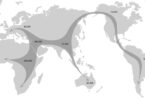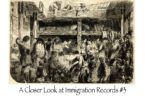Europeans have been coming to America since around the year 1000 A.D. when Vikings made a temporary settlement in Newfoundland. After an apparent (but not known with certainty) break for a few centuries, they started coming again in 1492. Most of the people who came were explorers, and they stayed temporarily, plundered the Native populations for riches and the natural landscape for resources, and then went home. Some stayed in the western part of the continent as missionaries to the Native Americans, a few stayed in isolated forts to protect the claims of their nations against other European nations who may be interested in claiming the same land. Others came seasonally to hunt and trap animals to trade their fur for other goods (this was primarily the French), and spent the rest of the year at home.
It was only truly in 1607, with the English settlement of Jamestown in Virginia that civilian immigrants from Europe came to stay in North America on a permanent basis in large numbers. Beginning with these immigrants, jumping to the Mayflower thirteen years later, and all the ships coming to New England in the Great Migration in the several decades following that, you will be able to find immigration records of all sorts, all the way up to the present day. Since everyone in America has some ancestral roots that begin elsewhere, except for full-blooded Native Americans, that means everyone who is a genealogist can potentially benefit from researching immigration records.
The earliest immigration records are likely to be found in ship manifests. If your ancestors were military people who went on exploratory trips or manned the earliest forts or were priests, monks, or nuns who came to attempt to convert the Native Americans, you might be able to find records of them coming to America in the military and religious records of their native countries, as there were no local European-based governments, per se, in North America that early in its settlement history. Most people with European roots whose families came to America early on will be looking at 17th-century ship manifests.
These manifests list the name of the ship that sailed, the names of the crew, the point of departure, the intended destination, and the names of the people who sailed on the ship, both professional and civilian. People with the same surname on the same ship are likely but not always) part of the same family. The crew usually (but not always) went back to Europe after dropping off their soldier and civilian passengers. Even the crew of the Mayflower went back to England.
You can find these manifests in the archives of your ancestor’s country of origin and on some online genealogy websites. They are useful to look at, as they will tell you when your earliest American ancestors came, what port in Europe they went to in order to get on the ship, and possibly which family members came with them. You can then check this information against other records both in Europe and in America in the place your ancestor settled when they arrived in order to find out more about them, and what their journey to America and their early time there was like. It’s a great place to start when researching ancient Americans familiar from Europe.




